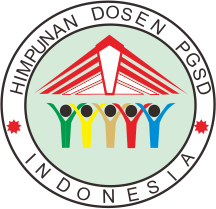PENGEMBANGAN MEDIA PEMBELAJARAN TEKNIK DASAR BOLA VOLI UNTUK SISWA SEKOLAH MENENGAH PERTAMA
DOI:
https://doi.org/10.30595/dinamika.v6i2.911Keywords:
learning media, basic techniques volleyballAbstract
This study aims to produce learning media of volleyball basic technique for junior high scholl students. The study used research and development design. The prosedures were done as follow: (1) doing need analysis, (2) developing assessment instruments, (3) developing and selecting instructional materials, (4) designing and conducting formative evaluation of instruction, and (5) making final product. The small scale trial was conducted to 30 students of SMP N 1 Jetis, while the bigger scale trial was done to 57 students (28 students of SMP N 1 Bantul and 29 of SMP N 1 Imogiri). Product quality assessment involves 3 physical education teachers. The instruments which were used in collecting data were: (1) general interview instruction, (2) validation scale questionnaire, and (3) questionnaire of quality scale of the learning media. The research show that the validations; (1) from material expert is very good, (2) from media expert is very good, (3) from overall students is very good, (4) from teacher is very good.The effectiveness of learning media was 5.4 on pretest and 8.6 on posttestReferences
Agus Mahendra. 2003. Falsafah pendidikan jamani. http :// www . ditplb.or.id/profile.php?id=65. Diunduh tanggal 22 Juli 2012.
Anonim. (2012). Meaning anddefinition of physical education, body fitness and health education. http :/ / body fitness health . com / meaning – and – definition – of - physical- education
Diunduh tanggal 22 Juli 2012.
Anonim.(2012).http://www.adobe.com/devnet/flash/articles/flash_cs5_createfla.html. Diunduh tanggal 19 Juli 2012.
Bergeles Nikos. (2010). Performance effectiveness in complex II of olympic-level male and female volleyball players.Grigoris National and Kapodistrian University of Athens, Faculty of Physical Education and Sports Science, Greece. Jurnal. Tersedia: http://www.fivb.org/EN/Medical/Document/2010_IJVR.pdf. Diunduh tanggal 29 Maret 2013.
Gall, Meredith D., Gall, Joyce P., & Borg, Walter R. (2003). Educational research: an introduction (7th ed). United States of America: Pearson Inc.
Mulyati. (2005). Psikologi belajar. Yogyakarta: Andi Offset.
Newby, T. J. et all. (2004). Instructional technology for teaching and learning. New Jersey: Prentice Hall Inc.
Pupuh Fathurrohman. (2007). Strategi belajar mengajar melalui penanaman dan konsep islami. Bandung: PT Refika Aditama.
Riduwan. (2007). Skala pengukuran variabel-variabel penelitian. Bandung: Alfabeta.
Smaldino, S. E., Lowther, D. L., & Russell, J. D. (2008). Intructional technology and media for learning ( ed.) New Jersey: Pearson.
Sugihartono dkk. (2007). Psikologi pendidikan. Yogyakarta: UNY Press.
Sukardjo. (2005). Evaluasi pembelajaran. Diktat mata kuliah evaluasi pembelajaran. Prodi TP PPs UNY. Tidak diterbitkan.
Sumiati. (2008). Metode pembelajaran. Bandung: Wacana Prima.
Vaibhav Rai, (2013). A study on physiological characteristics of national volleyball players. Research on Humanities and Social Sciences. Jurnal. Tersedia: http :// www . iiste . org/Journals/index.php/RHSS/article/view/4997/5093.
Diunduh tanggal 27 April 2013.
Walker, D. F. & Hess, R. D. (2000). Instructional software. California: Wadsworth Publishing Company, Belmot
Downloads
How to Cite
Issue
Section
License
Authors who publish with this journal agree to the following terms:
Authors retain copyright and grant the journal right of first publication with the work simultaneously licensed under a Creative Commons Attribution License that allows others to share the work with an acknowledgement of the work's authorship and initial publication in this journal.
Authors are able to enter into separate, additional contractual arrangements for the non-exclusive distribution of the journal's published version of the work (e.g., post it to an institutional repository or publish it in a book), with an acknowledgement of its initial publication in this journal.
Authors are permitted and encouraged to post their work online (e.g., in institutional repositories or on their website) prior to and during the submission process, as it can lead to productive exchanges, as well as earlier and greater citation of published work (See The Effect of Open Access).

Dinamika Jurnal Ilmiah Pendidikan Dasar is licensed under a Creative Commons Attribution 4.0 International License.













